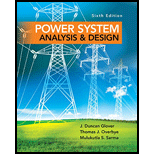
Power System Analysis and Design (MindTap Course List)
6th Edition
ISBN: 9781305632134
Author: J. Duncan Glover, Thomas Overbye, Mulukutla S. Sarma
Publisher: Cengage Learning
expand_more
expand_more
format_list_bulleted
Concept explainers
Question
Chapter 7, Problem 7.32P
To determine
The circuit breaker for the given line.
Expert Solution & Answer
Want to see the full answer?
Check out a sample textbook solution
Students have asked these similar questions
A Digital Filter is described by the
following. difference equation:
Y(n)=0.5x(n) 0.5(n-2)
-
Find the transfer function ..
Q4) answer just two from three the following terms:
A) Design ADC using the successive method if the Vmax=(3) volt, Vmin=(-2) volt, demonstrate the
designing system for vin-1.2 volt.
(a) For a voltage phasor V(jω) and a current phasor I(jω), give an expression for the complex power.(b)Give three examples of how real (average) power might be dissipated.(c)A time-domain voltage is defined by the expression v(t)= 5 cos(πt/3) V. When this is applied across an impedance Z = 4∠60° Ω, determine:(i)The instantaneous power.(ii)The average power.
Chapter 7 Solutions
Power System Analysis and Design (MindTap Course List)
Ch. 7 - Even though the fault current is not symmetrical...Ch. 7 - The amplitude of the sinusoidal symmetrical ac...Ch. 7 - Equipment ratings for the four-bus power system...Ch. 7 - Equipment ratings for the five-bus power system...Ch. 7 - Prob. 7.22PCh. 7 - A three-phase circuit breaker has a 15.5-kV rated...Ch. 7 - Prob. 7.32P
Knowledge Booster
Learn more about
Need a deep-dive on the concept behind this application? Look no further. Learn more about this topic, electrical-engineering and related others by exploring similar questions and additional content below.Similar questions
- Consider the LTI system with the input x(t) = e^28(t) and the impulse response h(t) = e−²tu(t). a) Determine the Laplace transform of x(t) and h(t). (10 marks) b) Using convolutional property, determine the Laplace transform and the ROC for the output response y(t).arrow_forward解出R1和R2arrow_forwardAccording to the book the answers are m= 30 and n = 5 and number of switch blocks is 220arrow_forward
- find reactive power demand , capacitor bank provides and overcompenstationarrow_forward(A) Consider a communication system where the number of successful transsions out of 10 trials follows a binomial distribution. The success probability for each triat is 0,95, Let X be the random variable representing the number of successful transmissions. -Sketch the cumulative distribution function (CDF) of the distribution. 2- Find Skewness coefficients and check if the distribution is symmetrical or skewed to the right or left. 3- Find kurtosis coefficients, Check if the distribution is mesokurtic, leptokurtic or platykurtic. 4- Find the probability of getting at most eigh. successful transmissions. 5- Find the probability P(20 with a mean 2-1 calculate the probability that the noise is greater than 3 units.arrow_forwardQ4: (A) Find the mean of a random variable X if S f(x)= 2x 0 2 for 0arrow_forward(A) Suopces the current measurements in a strip of wire are normally distributed with ca-10(mA) and a varieocom (mA)² 1- What is the probability that a current measurement lies between 7.4 and 11.6 mA? 2-Drew the probability density function of the current distribution. (8) A factory produces light bulbs with a koown probability of P(D)-0.08 that & bulo is dalective. If a bulb is defective, the probability that the quality control test detects it is defective is P(TID)-0.90. Conversely, if a bulb is not defective, the probability that the test Telesly indicaton k as defective is P(TID)-0.05. calculate the probability that a light b is notually defective given that the test result is positive, F(DIT).arrow_forwardTitle: Modelling and Simulating Boost Converter Battery Charging Powered by PV Solar Question: I need a MATLAB/Simulink model for a Boost Converter used to charge a battery, powered by a PV solar panel. The model should include: 1. A PV solar panel as the input power source. 2. A Boost Converter circuit for voltage regulation. 3. A battery charging system. 4. Simulation results showing voltage, current, and efficiency of the system. Please provide the Simulink file and any necessary explanations.arrow_forwardPlease answerarrow_forwardarrow_back_iosSEE MORE QUESTIONSarrow_forward_ios
Recommended textbooks for you
 Power System Analysis and Design (MindTap Course ...Electrical EngineeringISBN:9781305632134Author:J. Duncan Glover, Thomas Overbye, Mulukutla S. SarmaPublisher:Cengage Learning
Power System Analysis and Design (MindTap Course ...Electrical EngineeringISBN:9781305632134Author:J. Duncan Glover, Thomas Overbye, Mulukutla S. SarmaPublisher:Cengage Learning EBK ELECTRICAL WIRING RESIDENTIALElectrical EngineeringISBN:9781337516549Author:SimmonsPublisher:CENGAGE LEARNING - CONSIGNMENT
EBK ELECTRICAL WIRING RESIDENTIALElectrical EngineeringISBN:9781337516549Author:SimmonsPublisher:CENGAGE LEARNING - CONSIGNMENT

Power System Analysis and Design (MindTap Course ...
Electrical Engineering
ISBN:9781305632134
Author:J. Duncan Glover, Thomas Overbye, Mulukutla S. Sarma
Publisher:Cengage Learning

EBK ELECTRICAL WIRING RESIDENTIAL
Electrical Engineering
ISBN:9781337516549
Author:Simmons
Publisher:CENGAGE LEARNING - CONSIGNMENT
Fault Analysis in Power Systems part 1a; Author: GeneralPAC: Power System Tutorials;https://www.youtube.com/watch?v=g8itg4MOjok;License: Standard youtube license